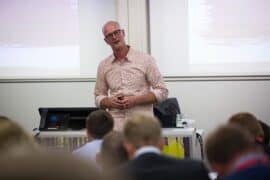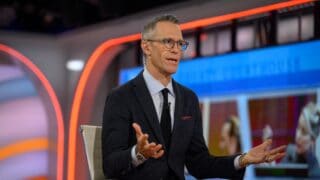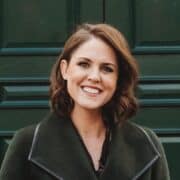The Lavin Agency Speakers Bureau
A speakers bureau that represents the best original thinkers,
writers, and doers for speaking engagements.
A speakers bureau that represents the best original thinkers,
writers, and doers for speaking engagements.
The world has changed overnight. Learn the science-based blueprint for how to change with it.
If the last few years have taught us anything, it’s how vital it is to adapt. But why is change so hard? And how can we diagnose complacency and conquer our goals? Award-winning behavioral scientist and Wharton professor Katy Milkman has devoted her career to understanding change. Milkman uses science, humor, and real-world stories from her groundbreaking book How to Change to show us how we can overcome our most difficult obstacles. She was twice named to the Thinkers50, often referred to as the Oscars of Management Thinkers, and features in a Masterclass on navigating change. In her talks, she offers a science-based blueprint for adapting our behavior (and the behavior of those we lead, manage and coach) to the demands of the rapidly changing world.
“Brilliant. Personal. And best of all, actionable. A highlight reel of what scientists know about how to change behavior for good.”— Angela Duckworth, #1 New York Times bestselling author of Grit
Katy Milkman co-founded and co-directs the University of Pennsylvania’s Behavior Change for Good Initiative, alongside her Wharton colleague and fellow Lavin speaker, Angela Duckworth. Milkman is the person best equipped to help us make the most of this figurative “blank slate”: not only teaching us how to create change, but make it stick. Whether you hope to nudge yourself, your employees, your customers, or your clients, now is the time to move forward with the changes you’ve always wanted to make. And no matter if the goal is to be more productive, save more for retirement, get more out of enrichment programs, or achieve health and wellness targets—Milkman is ready to help.
Decades of research have taught Milkman—host of Charles Schwab’s popular behavioral economics podcast Choiceology—that the key is to understand what’s standing between you and success, and tailor your solution to that roadblock. Too often, people reach for one-size-fits all solutions that sound appealing but lack a basis in evidence. Milkman’s cutting-edge research illustrates how to identify and overcome the barriers that regularly stand in the way of change. Her discoveries help explain why timing can be everything when it comes to making a change, how to turn temptation and inertia into assets that can help you conquer your goals, and why giving advice, even if it’s about something you’re struggling with, can help you achieve more, too.
Bestselling author Charles Duhigg called Milkman’s book How to Change: The Science of Getting from Where You Are to Where You Want to Be “a must read for anyone looking to improve their habits or their life”; Charles Schwab declared it “an invaluable guide to success”; and Laszlo Bock, CEO of Humu and former Google SVP of People Operations, says, “If your goal is to get better, or to make your teams or business better, read this book.” How to Change has been translated into over 20 languages, and The Financial Times named it one of the 10 best books on business to pick up in summer 2021. The book also made The Behavioral Scientist’s summer book list as well as Adam Grant’s personal list of 12 books every leader should read this summer.
Milkman’s research is transforming our understanding of behavior change. She’s been named twice to the Thinkers50 and was one of three experts interviewed for Jay Shetty’s “Navigating Change” Masterclass. She’s the former president of the International Society for Judgment and Decision Making, and one of Wharton’s most sought-after teachers. Milkman has also worked with or advised dozens of organizations on how to spur positive change, including Google, the U.S. Department of Defense, the American Red Cross, 24 Hour Fitness, Walmart, Morningstar, and the White House. Her research and insights are frequently covered by major media outlets such as The New York Times, The Wall Street Journal, The Economist and NPR.
Katy was incredible. She was really fun and engaging, and her content landed incredibly well with the team. It spurred a lot of dialogue after on how the team could apply her principles to the work we do in our org – which was the exact result we were looking for.
MicrosoftKaty was fantastic. Her command of the subject matter is unparalleled, and her speaking style drew in the entire audience. Very engaging despite being 100% virtual.
DeloitteKaty was FANTASTIC! Our audience really enjoyed her content: 90% of respondents gave her the highest or second-highest rating. In addition, Katy was a real pleasure to work with preparing for and at the event. I know our speaker manager was just raving about her.
1st Global
Author, Today Was Fun: A Book About Work (Seriously) Workplace Culture Expert Senior Advisor, SYPartners

Author, Lucky by Design Wharton Professor of Business Economics and Public Policy Forbes 30 Under 30 in Law and Policy

Harvard Business School Behavioral Science Professor "40 Under 40 MBA Professor" Author of TALK: The Science of Conversation and the Art of Being Ourselves

Harvard Kennedy School Professor Author, How to Disagree Better

Speaker on Stress and Leadership in the Workplace Columbia Business School Professor Host, TED Business Podcast Expert, Limitless with Chris Hemsworth

Professor of Organizational Behavior at London Business School Author of Alive at Work

Author of The Loop: How A.I. is Creating a World without Choices and How to Fight Back NBC News Technology Correspondent Former Editor-in-Chief of Popular Science Magazine AI Strategic Advisor to Fortune 500 Companies

Harvard Economist MacArthur Genius Studying Economic Opportunity Director of Opportunity Insights

Instant New York Times Bestselling Author of Empire of AI TIME100 AI Honoree Lead Designer of The Pulitzer Center's AI Spotlight Series

Author of Grit, the #1 New York Times Bestseller | Pioneering Researcher on Grit, Perseverance, and the Science of Success

2024 Nobel Prize Winner | 3rd Most Cited Economist in the World | Bestselling Co-Author of Why Nations Fail and Power and Progress

Harvard Business School Behavioral Science Professor | "40 Under 40 MBA Professor" | Author of TALK: The Science of Conversation and the Art of Being Ourselves

#1 New York Times Bestselling Co-Author of Abundance | Host of thePlain English Podcast | Founder of the Substack Derek Thompson

#1 New York Times Bestselling Author of How the Word Is Passed and Above Ground | The Atlantic Staff Writer

How can each person in your organization achieve more? Too often, when leaders set ambitious goals for their teams, those goals aren’t achieved. While conventional wisdom relies on “one-size-fits-all” solutions to help leaders and those they manage tackle new goals, such solutions are often ineffective. But award-winning behavioral scientist Katy Milkman has a different approach. Her international bestselling book, How to Change, is the antidote to run-of-the-mill self-help books that promise change but don’t show you how to get there, which is why the New York Times proclaimed “if you buy one self-help book this year, pick this one.” It’s a brilliant, science-based guide that addresses the specific obstacles in your way, and teaches you, with compelling research and stories, how to overcome them. Her accompanying talk is just as captivating and actionable—explaining things like why timing can be everything when it comes to making a change, or how to turn temptation and inertia into assets that can help you conquer your goals.
Whether you’re a manager, coach, or teacher encouraging change in others, or you’re kick-starting change in yourself, seize this moment and learn how to come out on top with Milkman’s science-based blueprint for getting where you want to be.”

Employee and customer choices are heavily dependent on context. Katy Milkman, an expert in the ways we consider options and make decisions, understands this from her extensive research studying these populations as a behavioral economist. ‘Choice architecture,’ or simply the way in which a choice is presented (on screens and in person) can thus be an extremely valuable tool for improving employee outcomes and consumer choices.
In this informative keynote, Milkman teaches audiences how to make use of the malleability in how choices are made to influence behavior for the better, providing insights about how to encourage improved decisions—online, at work, and at home. Covering the basics of wise choice architecture, nudges that have been proven to increase the likelihood of optimal decisions, and actionable takeaways tailored for your business or organization, Milkman leads a funny, fast-paced, and practical talk about how we can guide employee and customer behavior in the most helpful ways possible.

In a perfect world, people would always make perfect decisions. But we’re far from perfect: biases, irrational assumptions, and other overriding impulses make our decision-making processes fraught at best. Over the past 30 years, psychologists and economists have joined forces to study how people process information and actually make decisions, rather than how people would make decisions if they were fully rational and without bias. This research program—dubbed behavioral economics—has given us a deeper understanding of how decisions deviate from optimal choices, as well as the (sometimes grave!) consequences of such deviations. Put plainly, people are poor intuitive statisticians, and that means when they ‘just think’ about situations in which some data or casual observations exist, they tend to make serious inferential errors—and systematically biased decisions.
Throughout this engaging keynote, Katy Milkman discusses the most common errors we make, with particularly important implications for managerial and workplace settings. Using evidence-based examples, she introduces a number of common decision biases that influence managers, employees and consumers alike. She can then discuss the best research-based strategies we can use to avoid these biases. With her guidance, we can improve our awareness of situations where business biases are likely to arise, and thereby improve the quality of the decisions we make.